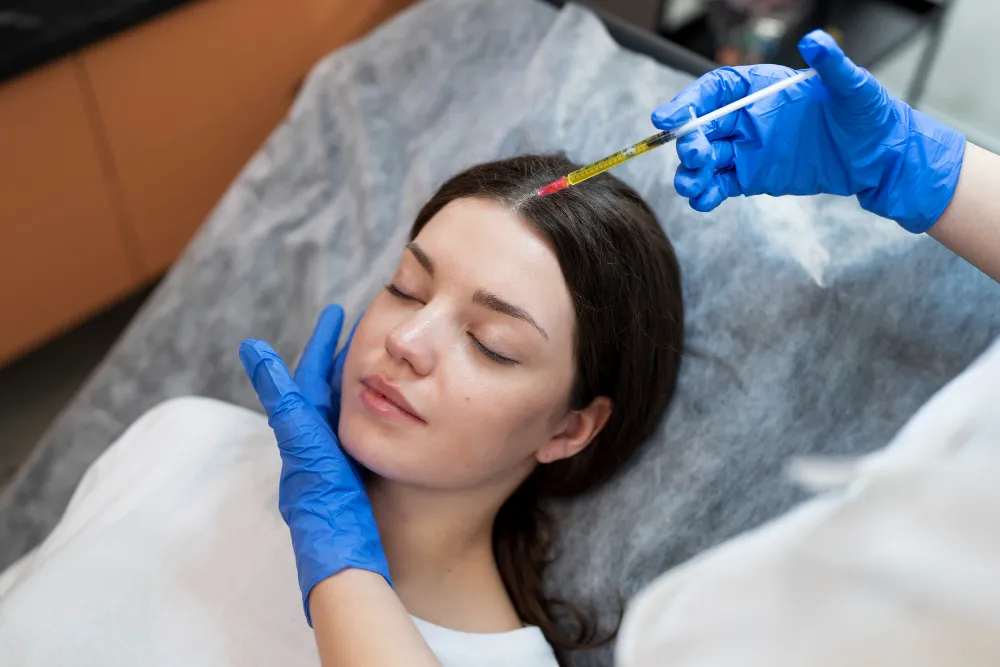PRP
What is PRP for Hair Loss?
PRP (Platelet-Rich Plasma) therapy is a non-surgical procedure that utilizes the growth factors and stem cells from your own blood to stimulate hair growth. It helps revive resting or miniaturized hair follicles to promote new hair growth, making it an effective treatment for hair loss or thinning.
The process begins with drawing a small amount of blood (20-22cc) from the patient, which is then placed in a centrifuge. The centrifuge separates the platelets from the rest of the blood. The plasma, now rich in platelets, is collected and prepared for injection into the scalp, where it promotes hair growth.
Additional Hair Loss Treatments
In addition to PRP, other effective treatments for hair loss include:
-
Low-Level Laser Light Therapy (LLLT): This technology uses red and near-infrared wavelengths to promote healing and stimulate hair growth by increasing blood flow and reducing inflammation in the scalp.
-
Mesotherapy: This procedure injects natural plant extracts, vitamins, and medications like finasteride or minoxidil directly into the scalp. Mesotherapy is designed to correct hormone imbalances, improve blood circulation, and deliver essential nutrients to the hair follicles.

Need Help
Frequently Asked Questions
Here are some commonly asked questions about PRP treatment for hair loss and its benefits.
1. Does platelet-rich plasma work for hair loss?
According to research from 2014, PRP injections are effective in treating androgenic alopecia, which is also known as male pattern baldness.
2. Does PRP treatment regrow hair?
PRP treatment is a non-surgical medical procedure where concentrated plasma rich in growth factors and nutrients, separated from your own blood, are injected into parts of your scalp that need hair growth. It is a safe and effective way to reverse hair loss and activate new hair growth.
3. How fast does PRP work for hair loss?
PRP hair restoration produces noticeable results after just four to six weeks. However, it may take approximately 3.5 months before you see the results you were looking for. Ideal results may require up to three sessions spaced one month apart.
4. How many PRP sessions should I take for hair loss?
Most PRP therapy requires three treatments 4–6 weeks apart. Maintenance treatments are recommended every 4–6 months.
5. What are the side effects of PRP?
Injury to blood vessels or nerves, scar tissue, calcification at injection points, and infection are some of the possible side effects of PRP treatment.
6. How many times can you have PRP?
Up to three PRP injections may be given within a six-month time frame, usually performed two to three weeks apart.
7. How do I prepare for PRP hair treatment?
Stop taking any alcohol and, if you must have some, restrict it to one or two drinks. Increase your water intake to compensate for the effects of alcohol.
8. Who is a good candidate for PRP hair treatment?
Studies have shown that the best candidates for PRP therapy are those whose hair loss is recent, as it can be difficult to revive long-dormant hair follicles. Ideal candidates have areas of "weak-quality" hair growth where functioning hair follicles remain.
9. What should I avoid after PRP?
Avoid coloring your hair or getting a perm for at least 72 hours after the PRP injections. The chemicals can irritate the injection sites and potentially cause complications.
What Our Clients Say
Contact Us
Send A Message
If you want to ask anything just fill in the form below and send us.
